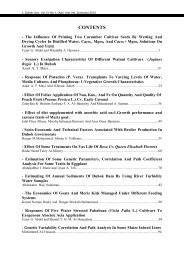You also want an ePaper? Increase the reach of your titles
YUMPU automatically turns print PDFs into web optimized ePapers that Google loves.
J. Duhok Univ., Vol.14, No.1 (Pure and Eng. Sciences), Pp 9-16, 2011<br />
ON CP-OPEN SETS AND TWO CLASSES OF FUNCTIONS<br />
ALIAS B. KHALAF * and SHILAN A. MOHAMMAD **<br />
* Dept. of Math., Faculty of Science, University of Duhok, Kurdistan Region-Iraq<br />
** Dept. of Math., Faculty of Science, University of Zakho, Kurdistan Region-Iraq<br />
(Received: October 1, 2009; Accepted for publication: November 3, 2010)<br />
ABSTRACT<br />
In this paper we introduce the concept of cp-open set and study some of its properties. Further we introduce the<br />
cp-continuous and cp-open functions and investigate the basic propertied. Necessary and sufficient condition of P1 -<br />
closed graph and cp-continuous function were found.<br />
KEYWORDS: c-open set, cp-open set, cp-continuous and cp-open functions, P1 -closed graph.<br />
T<br />
1. INTRODUCTION AND<br />
PRELIMINARIES<br />
hroughout the present paper, X and Y<br />
denote topological spaces in which no<br />
separation axiom is assumed. Let A be a subset<br />
of X, we denote the interior and the closure of a<br />
set A by int(A) and cl(A) respectively. A subset<br />
A is said to be preopen [10] (resp. semi open[7])<br />
set if A � intcl(A)( resp. A � clint(A)). The<br />
complement of a preopen set is called preclosed.<br />
The intersection of all preclosed sets containing<br />
A is called the preclosure of A and is denoted by<br />
pcl(A). The preinterior of A is defined as the<br />
union of all preopen sets contained in A and is<br />
denoted by pint(A). The family of all preopen<br />
sets of X is denoted by PO(X) and the set of all<br />
preopen set containing x�X is denoted by<br />
PO(X, x). The union of any family of preopen<br />
sets is preopen. A subset N of X is<br />
preneighbourhood[12] of a point x of X if there<br />
exists a preopen set U containing x with U � N<br />
and it is denoted by N p (x).<br />
As stated by Mashhour et al.[10], Katetov<br />
made some comments on the paper [9] to find<br />
conditions under which the intersection of any<br />
two preopen sets is preopen.<br />
Mashhour together with others offered an<br />
answer to this remark in the form of a<br />
theorem[10, Theorem 2.3].<br />
Definition 1.1[16]. A space (X, � ) will be said<br />
to have the property P if the closure is preserved<br />
under finite intersection or equivalently, if the<br />
closure of intersection of any two subsets equals<br />
the intersection of their closures.<br />
Lemma 1.2[16]. From the above definition it<br />
readily follows that if a space X has the property<br />
P, then the intersection of any two preopen sets<br />
is preopen. As a consequence of this PO(X) is a<br />
topology for X and it is finer than � .<br />
Lemma 1.3[4]. Let A and X 0 be subsets of a<br />
space X. If A�PO(X) and X 0 is semi open in X,<br />
then A � X 0 �PO(X 0 ),<br />
Lemma 1.4[2]. If A � Y � X and Y is a preopen<br />
set in X, then A�PO(X) if and only if<br />
A�PO(Y).<br />
Definition 1.5. A function f : X �Y is called:<br />
1- preirresolute[15] if f<br />
� 1<br />
(V)�PO(X) for each<br />
preopen set V of Y.<br />
2- M-preopen[16] if the image of every preopen<br />
set in X is a preopen set in Y,<br />
3- M-preclosd[13] if the image of every<br />
preclosed set in X is a preclosed set in Y.<br />
Definition 1.6[1]. Let f :X � Y be any<br />
function, the graph of the function f is denoted<br />
by G( f ) and is said to be P1 -closed if for each<br />
(x, y)�G( f ), there exist U�PO(X,x) and<br />
V�PO(Y,y) with (U� V) � G( f )= � .<br />
We proved if the graph of f is P1 -closed<br />
and X has the property P, then the inverse image<br />
of a strongly compact subset in Y is preclosed<br />
set in X.<br />
Definition 1.7[4]. A space X is said to be<br />
submaximal if every dense subset of X is open.<br />
Lemma 1.8[4]. A space X is submaximal if and<br />
only if every preopen set is open.<br />
Definition 1.9. A space X is:<br />
1- pre- T 1 [11] if for every distinct points x, y of<br />
X, there exists U�PO(X, x) not containing y<br />
and V� PO(X, y) not containing x,<br />
2- T 2 [17](resp. pre- T 2 [11]) if for every distinct<br />
points x, y of X, there exist two disjoint<br />
open(resp. preopen) sets each containing one of<br />
them,<br />
9



